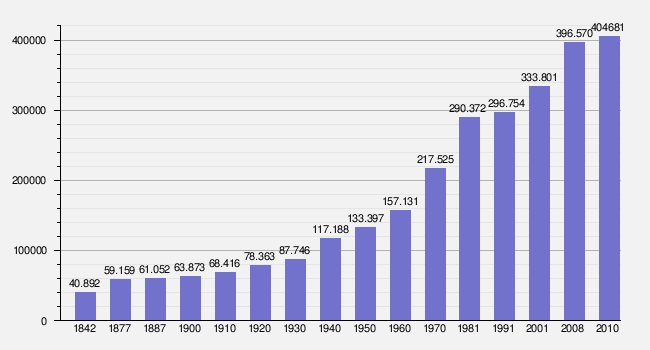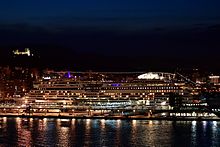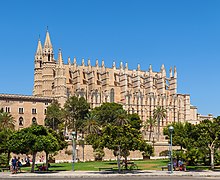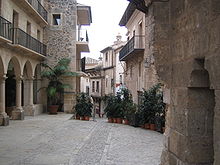Palma
| Palma | ||
|---|---|---|
| coat of arms | Map of Spain | |

|
|
|
| Basic data | ||
| Autonomous Community : | Balearic Islands | |
| Island: | Mallorca | |
| Comarca : | Palma city region | |
| Coordinates | 39 ° 34 ' N , 2 ° 39' E | |
| Height : | 15 msnm | |
| Area : | 208.7 km² | |
| Residents : | 416,065 (Jan. 1, 2019) | |
| Population density : | 1,993.6 inhabitants / km² | |
| Postal code : | 07000-07099 | |
| Municipality number ( INE ): | 07040 | |
| Nearest airport : | Palma Airport (8 km from the city center) | |
| administration | ||
| Official language : | Catalan , Spanish | |
| Mayor : | Antoni Noguera Ortega (MÉS per Mallorca) | |
| Address of the municipal administration: | Plaça de Cort, 1 07001 Palma |
|
| Website : | www.palma.cat | |
| Location of the city | ||
Mallorca and Cabrera
|
||
Palma , also Ciutat (de Mallorques) or Palma de Mallorca , is the capital of the Spanish Mediterranean island of Mallorca and the seat of the government of the autonomous community of the Balearic Islands .
Palma is the supply center of the Balearic Islands, where the government is also the largest port , the largest airport and most of the infrastructure. In addition, the city is a tourist magnet, as excursions are mainly offered here from the hotels scattered around the island.
At the beginning of October 2008 the addition “de Mallorca” in the name of the city and municipality of Palma was deleted from the Spanish municipal register. An application dating from 1998 was thus implemented. This was initially reversed by the city government on November 16, 2011. Since January 28, 2016 the name has been Palma again.
geography
Palma extends along the Bay of Palma on the coast of the Mediterranean Sea in the west of the island. The city's agglomeration is about 30 kilometers long and stretches along the coast from Magaluf in the west to S'Arenal in the east. With around 500,000 inhabitants, more than half of Mallorca's inhabitants live here.
To the north-west of the city lies the Serra de Tramuntana and to the north-east a few smaller ranges of hills that separate Palma from the central plains of Mallorca. To the east, the sandy beach of Platja de Palma extends over about ten kilometers to S'Arenal . To the west is the bay of Cala Major .
The center of the city is the historic old town within the city fortifications, which were demolished in 1902 and whose course is now followed by the urban ring road. This is followed by an approximately one to two kilometer wide belt of dense urban development, which includes the port in the southwest and is enclosed by the motorway ring. Outside the motorway ring ( Ma-20 ) are the suburbs and industrial areas, which are partly incorporated and partly form separate communities such as Marratxí .
In addition, the island of Cabrera , located south of Mallorca, belongs administratively to the municipality of Palma.
City structure
In addition to the core city of Palma, there are about 30 other localities of different sizes within the municipality. The following places and districts belong to the city:
|
|
The population figures in brackets are from January 1, 2008. The first number indicates the residents of the built-up areas, the second number the residents of the towns, including the “scattered” population outside the actual settlements. (Source: INE )
The municipal structure of the city comprises five districts, independently of them seven barriadas , as well as 89 units at the lowest level (85 barris and four other zones).
climate
| Palma, port (3 m) | ||||||||||||||||||||||||||||||||||||||||||||||||
|---|---|---|---|---|---|---|---|---|---|---|---|---|---|---|---|---|---|---|---|---|---|---|---|---|---|---|---|---|---|---|---|---|---|---|---|---|---|---|---|---|---|---|---|---|---|---|---|---|
| Climate diagram | ||||||||||||||||||||||||||||||||||||||||||||||||
| ||||||||||||||||||||||||||||||||||||||||||||||||
|
Average monthly temperatures and rainfall for Palma, port (3 m)
|
||||||||||||||||||||||||||||||||||||||||||||||||||||||||||||||||||||||||||||||||||||||||||||||||||||||||||||||||||||||||||||||||||||||||||||||||||||||||||||||||||||||||||||||||||||||||||||||||||||||||||||||||||
Annual mean temperatures have fluctuated between 16 ° C and 19 ° C since the beginning of the 20th century.
population
Residents
With 416,065 inhabitants (as of January 1, 2019), Palma is the largest municipality in terms of population, with 208.7 km², after Llucmajor and Manacor, the third largest municipality in Mallorca. The core city has 298,776 inhabitants (as of 2008).
The annual population growth of 2.5% (2001–2008 average) is mainly due to the strong immigration of foreigners. As a result, the proportion of local residents has declined, especially in recent years. Today 52.1% of the inhabitants are still native to the Balearic Islands, 45.2% of them from Palma. 25.7% of the population were born in the rest of Spain and 22.2% abroad.
A resident of Palma is called in Catalan palmesà / palmesana (or locally ciutadà / ciutadana ) and in Spanish palmesano / palmesana .
Development of the population:

Between 1910 and 1920 the population increased due to the incorporation of Establiments.
Nationalities
| origin | according to citizenship (2008) |
according to country of birth (2008) |
|---|---|---|
|
|
87.6% | 84.4% |
|
|
80.5% | 77.8% |
|
|
1.3% | 1.3% |
|
|
1.3% | 0.4% |
|
|
1.2% | 1.2% |
|
|
0.8% | 0.8% |
|
|
0.6% | 0.6% |
|
|
0.4% | 0.7% |
|
|
0.4% | 0.4% |
| other Europeans | 0.5% | 0.7% |
| North and South Americans | 8.4% | 11.3% |
|
|
1.7% | 1.8% |
|
|
1.4% | 2.8% |
|
|
1.4% | 1.4% |
|
|
1.3% | 1.5% |
| African | 2.5% | 2.6% |
|
|
0.9% | 1.0% |
|
|
0.6% | 0.5% |
| Asians | 1.0% | 1.1% |
|
|
0.5% | 0.5% |
The proportion of foreigners is 19.5% (2008, only main residence) and is growing rapidly. Between 2000 and 2008 alone, the number of foreigners increased sixfold. The proportion of foreign-born people is 22.2%, most of them from Latin America (11.3%).
Development of the proportion of foreigners:

history
In 123 BC BC Quintus Caecilius Metellus conquered with his fleet which had been in existence since 5000 BC. BC ( Talayot culture ) populated island of Mallorca. As one of his first official acts, the Roman consul founded the city of Palma (then under the name Palmaria Palmensis). After the fall of the Western Roman Empire in the 4th century, the city began to decline, which was only stopped with the conquest by the Arabs in 903. They built up an Arab-Islamic culture in Palma and were expelled from the island by the Aragonese in 1229 . The Kingdom of Mallorca was then founded (1276), but in 1343 it fell back to the House of Aragon after the line of rulers died out. The Aragonese expanded the city, including the construction of the La Seu cathedral and the city fortifications, so that at its heyday in the 16th century it had around 40,000 inhabitants. Together with Aragon, Mallorca later came to Spain , to which it still belongs to this day. A renewed upswing set in at the beginning of the 20th century, when many buildings were built in the style of Modernism . After the Second World War, mass tourism began on Mallorca, which has provided the city with a good economic base ever since.
Culture
Attractions
The main attraction of the city is the Gothic cathedral La Seu in the south of the old town not far from the coast. In addition, there are 31 other, mostly Gothic churches in the old town, such as the Basilica of Sant Francesc and the Church of Santa Eulàlia . Next to the cathedral is the palace, which the King of Spain uses as his residence when visiting the Balearic Islands.

The old town of Palma is a stylistic mixture of Spanish-Catalan and Arabic influences. It is known for its numerous narrow streets, some of which are only connected by stairs. As a result, the old town is largely car-free, apart from a few through streets. Its center is the Plaça Major . At the Plaça de Cort by the town hall there is a specially protected olive tree that is several centuries old.
The Castell de Bellver , a medieval castle complex , rises to the southwest and outside the old town above the harbor .
Llotja de Palma is not far from the port and the cathedral. It is another masterpiece of bourgeois Gothic architecture from Palma and was the former seat of the maritime trade exchange. It was built by the architect Guillem Sagrera from Felanitx , who was also involved in the construction of the Gothic cathedral La Seu.
The Catalan painter Joan Miró worked and died in Palma's suburb of Cala Major . In the house of his studio, where selected works can be viewed in addition to the studio, is now the headquarters of the Foundation Fundació Pilar i Joan Miró a Mallorca . In Palma there is also a contemporary art museum, the Es Baluard .
The municipality of Palma has a total of 15 controlled and monitored beaches, which have been designated as Balneario No 1 to 15. The beaches are located east of the city center in the district of Platja de Palma in the area of the locality of S'Arenal . There are many hotel complexes, restaurants, bars and discos in the vicinity . The Balneario No 6, known as Ballermann 6, is particularly well known in Germany .
Sports
Two major marathon events take place in Palma every year. The Ciutat Marathon (half marathon) starts in March and the big TUI Marathon Mallorca Marathon takes place every October . Well-known sports clubs from the city are the volleyball club Portol Drac Palma Mallorca , the basketball club Palma Air Europa, the futsal club Futsal Palma and the football club RCD Mallorca , whose home stadium is the Iberostar Estadi . In addition, there are weekly trotting races on the Son Pardo harness racing track in Palma.
Economy and Infrastructure
Palma is a service city. The dominant economic sectors are tourism, trade (marketing of local agricultural products), administration and transport (port and airport). Since the 1970s, no industrial companies have been allowed to settle in the area of the municipality of Palma, which is why they migrated to the municipalities of the north-eastern hinterland.
power supply
- List of power plants in the Balearic Islands
- Gasoducte Península-Illes Balears , natural gas supply
traffic
Palma is the transport hub of the Balearic Islands. Roads connect the city with all places in Mallorca. Motorways lead to Peguera in the west ( Ma-1 ), Alcúdia in the northeast ( Ma-13 ), Llucmajor in the southeast ( Ma-19 ) and as an urban highway around Palma ( Ma-20 ). There is an expressway to Manacor in the east (Ma-15).
Public transport on the island consists of a bus network and some railway lines , which are currently being expanded again. The city has a dense network of city buses and the Metro de Palma, which opened in 2007 . From 1891 there was a tram in Palma operated by the Sociedad Mallorquina de Tranvías . From 1916 it was operated electrically, but the lines were shut down in 1959 due to unprofitability. Around 50 years later, a new tram route was planned: The Tram Badia (“Bay Tram”) was to connect the center of the city at Plaça d'Espanya via Portitxol and Coll d'en Rabassa with the airport . The project has been budgeted for 207 million euros. Construction of the 10.8 km long route should start at the end of 2011 at the earliest. However, this project was not implemented.
Palma is connected to the European mainland by ferry connections to the cities of the Spanish Mediterranean coast and Palma Airport , from which almost all airports in Europe are served. In 2016, Spain's third-largest airport after Madrid and Barcelona had 26.2 million passengers, which in the German-speaking region is between Zurich (2016: 27.6 million) and Düsseldorf (2016: 23.5 million) airports.
media
Several Spanish print media appear in Palma, including the daily newspapers Ultima Hora (largest circulation), El Mundo Balear , Diario de Mallorca , as well as a daily newspaper in Catalan: dBalears - Diari de Balears . The English newspaper Majorca Daily Bulletin is also published daily . The two German-language weekly newspapers Mallorca Magazin and Mallorca Zeitung provide residents, vacationers and travelers with current and important information.
Also the German-speaking island radio Mallorca 95.8 The island radio is based in Palma. More than 15 Spanish and Catalan radio stations offer an extensive music and radio program in Palma, on the island of Mallorca and the Balearic Islands.
Resident institutions
In addition to the island government of the Balearic Islands, Palma is the seat of the Bishop of Mallorca and the University of the Balearic Islands . There is also a German school in Palma .
Personalities
sons and daughters of the town
- Ramon Llull (1232-1316), Catalan philosopher, theologian and logician
- Guillem Mesquida i Munar (1675–1747), Baroque painter
- Juan José Pérez Hernández (≈1725–1775), navigator and explorer
- Tomàs Aguiló i Forteza (1812–1884), poet, writer and journalist
- Antoni Ignasi Cervera (1825–1860), journalist and publisher
- Emili Pou y Bonet (1830–1888), engineer and port builder
- Valeriano Weyler y Nicolau (1838–1930), general and governor
- Eusebi Estada i Sureda (1843–1917), engineer and pioneer of traffic route construction
- Francesco Uetam (1847–1913), opera singer (bass)
- Joan Alcover i Maspons (1854–1926), poet and politician
- Gaspar Bennàssar i Moner (1869–1933), important architect for the city of Palma
- Miguel Roca Cabanellas (1921–1992), Roman Catholic Archbishop
- Arturo Pomar Salamanca (1931-2016), chess master
- Bernat Pomar (1932–2011), composer and violinist
- Fernando Aínsa (1937–2019), Spanish-Uruguayan writer
- Pere Morey i Severa (1941-2019), author
- Maria del Mar Bonet (born 1947), singer
- Carme Riera (* 1948), writer and literary scholar
- Carlos Mata (1949-2008), artist
- Agustí Fernández (* 1954), pianist and composer
- Jaume Matas (* 1954), politician
- Miguel Ángel Velasco (1963-2010), writer
- Rossy de Palma (born 1964), actress
- DJ Sammy (* 1969), DJ and music producer
- Antonio Tauler (* 1974), racing cyclist
- Carlos Moyá (* 1976), tennis player
- Llucia Ramis (* 1977), journalist and writer
- David Muntaner (* 1983), cycling trainer and racing cyclist
- Rudy Fernández (* 1985), basketball player
- Juanan (* 1987), football player
- Jorge Lorenzo (* 1987), motorcycle racer
- Miquel Julià Perello (* 1988), racing car driver
- Luis Salom (1991–2016), motorcycle racer
- Alejandro Abrines Redondo (born 1993), basketball player
- Marco Asensio (* 1996), football player
- Xavier Cañellas (* 1997), cyclist
- Joan Mir (* 1997), motorcycle racer
Personalities who have worked in the city
- Avram Cresques (around 1325–1387), cartographer
- Jehuda Cresques (around 1350–1427), cartographer
- Guillem Sagrera (around 1420–1440), sculptor and architect of the Gothic
- Ricardo Anckermann (1842–1907), painter
- Joan Miró (1893–1983), painter and sculptor
- Josep Maria Quadrado i Nieto (around 1820–1896), historian, writer and publicist
- Béla Just (1906–1954), writer in exile in Hungary
Individual evidence
- ↑ Cifras oficiales de población resultantes de la revisión del Padrón municipal a 1 de enero . Population statistics from the Instituto Nacional de Estadística (population update).
- ↑ Josep Capó: Palma ya no es ´de Mallorca´. Diario de Mallorca of October 8, 2008
- ↑ Cort aprova recuperar el nom de Palma by a la ciutat. Ara Balears January 28, 2016
- ↑ Comparison of Sectors and Districts. ( Memento of the original from March 4, 2016 in the Internet Archive ) Info: The archive link was inserted automatically and has not yet been checked. Please check the original and archive link according to the instructions and then remove this notice.
- ↑ [1] [2] (PDF; 2.2 MB) Population statistics ( Memento of the original from November 1, 2013 in the Internet Archive ) Info: The archive link was inserted automatically and has not yet been checked. Please check the original and archive link according to the instructions and then remove this notice. (PDF; 37 kB)
- ↑ GISS Surface Temperature Analysis, Station Data: Palma de Mallorca. National Aeronautics and Space Administration, Goddard Institute for Space Studies (English).
- ↑ GISS Surface Temperature Analysis (v4), Station Data: Palma. National Aeronautics and Space Administration, Goddard Institute for Space Studies (English).
- ^ Instituto Nacional de Estadística: Alterations to the municipalities in the Population Censuses since 1842.
- ^ Instituto Nacional de Estadística: Population by sex, municipalities and nationality
- ^ Instituto Nacional de Estadística: Population by sex, municipalities and place of birth
- ↑ 7th International TUI Marathon “Ciutat de Palma”. www.infomallorca.net, accessed December 19, 2010 .
- ↑ Mallorca relies on the rails. In: Mallorca Magazin issue 460/2009, pages 4/5 ( page no longer available , search in web archives ) Info: The link was automatically marked as defective. Please check the link according to the instructions and then remove this notice.
- ↑ 100 years of trams in Palma: Progress at a rapid pace. Mallorca Newspaper, July 1st 2016
- ↑ Aviation in Spain, Statistics 2016 , Aena, accessed on August 28, 2017














